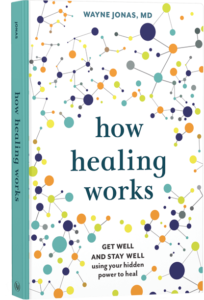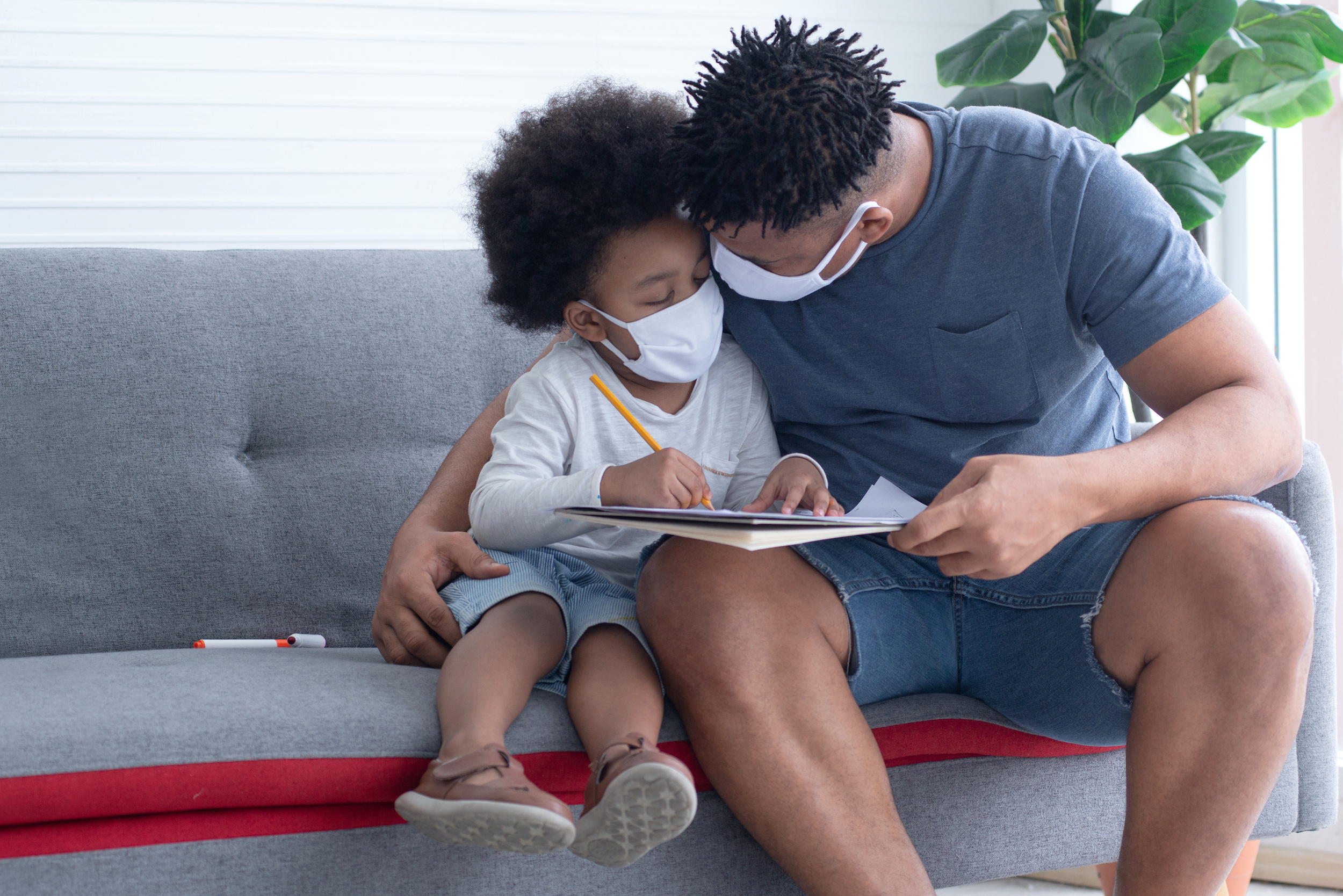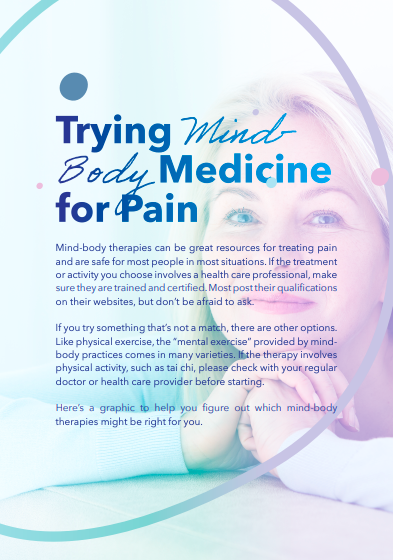Mind-body practices . . . focus on the interactions of mind, body, and behavior, with the intent to use the mind to affect physical functioning and promote health.
–National Center for Complementary and Integrative Health, NIH
If you have children, chances are good that when they get sick or injured you put on a favorite video, kiss their wound, rub their backs, play a game or allow some extra screen time. Distraction and hands-on techniques like touch and massage are mainstays of non-drug pain relief for kids and teens. And with good reason. Pain medication may work differently in younger people, and some medicines such as aspirin can actually harm young patients. Hospitals use mind-body techniques to relieve pain in children undergoing tests, cancer treatments and more. These therapies include guided imagery, muscle relaxation techniques, deep breathing and giving children a sense of control by explaining procedures before they happen. Kids may also get to choose their own positions for procedures, such as sitting on a parent’s lap. Other well-known techniques include having kids watch videos or listen to music during procedures such as dental treatments or MRI. Virtual reality is also starting to be used to help reduce the experience of pain in children. What do these pain relief methods have in common? All of them shift the focus off pain, calm the mind and relax the body.
What Works for Kids Can Work for You
We care for our children well, but we don’t always do the same for ourselves, especially when things are stressful. Yet adults also benefit from mind-body methods of pain relief. Right now, you might have an achy wrist or knee because your scheduled surgery has been delayed due to COVID-19 precautions. Stress and increased noise levels at home may be contributing to migraines. Or stay-home, stay-safe orders might have you missing the workout that normally keeps your lower back pain in check. This article describes specific mind-body practices to help you give yourself the same TLC you give your kids. There are many options to shift your focus, calm your mind and relax your body – and these can turn down or eliminate pain.
Mind-Body Treatments for Everyone
Let’s start with a common example: low back pain. This is one of the most common conditions affecting U.S. adults. Many believe surgery is the ultimate answer. But according to the American College of Physicians (ACP) and American Pain Society (APS), mind-body practices like tai chi, yoga, mindfulness and cognitive-behavioral therapy can all relieve lower back pain effectively.
The Mind and Healing
As research on the placebo effect shows, the meaning and context of a treatment have immense power to heal. Being surrounded by caring friends and family can bring relaxation and comfort – something every parent who has ever sat at a child’s bedside already knows. Other mind-body therapies for pain include the following.
Meditation and Mindfulness
In traditional meditation, you may sit or lie down, repeat calming words, or focus on your breath or a mental image. The US military uses meditation training to teach troops to remain calm and centered in stressful situations. A 2016 study funded in part by the National Center for Complementary and Integrative Health (NCCIH) found that mindfulness meditation helped control pain even without tapping into the natural opiates we produce in our brains. Combining mindfulness with pain medication and approaches that use the brain’s natural painkillers might be even more effective than either technique on its own. A recent National Public Radio story featuring Dr. Jonas demonstrates how meditation can help people reduce their use of opioid medications for pain control. You can learn meditation on your own at home from an app such as Headspace. Even a few minutes a day can help.
Moving Meditation
Tai chi, yoga and qi gong are ancient styles of movement-based meditation. Instead of sitting still, you learn a series of movements and poses, often done with a group. Tai chi, which includes breath control and meditation, developed from the older discipline of qi gong. Studies have shown that it benefits many conditions. For example:
- A 2016 study of more than 200 people found that tai chi produced beneficial effects similar to those of standard physical therapy for knee arthritis.
- A 2013 review of 7 separate research studies and nearly 350 people found that practicing tai chi for 12 weeks helped relieve arthritis pain and improve knee function.
- A 2018 study of 226 adults with fibromyalgia found that tai chi twice a week made symptoms less severe. After 6 months, people in the tai chi group felt better than in a group that did aerobic exercise, and fewer of them dropped out of the tai chi program.
Qi gong may help several types of muscle pain and a severe condition called complex regional pain syndrome type 1. Our pocket guide to moving meditations has information on these mind-body therapies.
Hypnosis
Despite what you see in movies, a swinging pocket watch is not required for effective hypnosis. This state of deep concentration, practiced with a certified hypnotherapist or an app or recording, can help treat addictions such as smoking and disorders such as anxiety. Hypnosis also helps relieve chronic pain and cancer pain in children and is a promising treatment for chronic pain in adults. It is also helpful to reduce pain and complications after surgery. The related technique of self-hypnosis can help your body produce its natural “relaxation response.” This is the opposite of the stress response, which you may know as “fight or flight.” When researchers studied more than 200 women having breast biopsies, they found that those who received either self-hypnosis with an audio program or caring attention from a research assistant experienced less pain and anxiety than women who did not get mind-body therapies.
Therapeutic Suggestion
Also called suggestion therapy, this treatment is different from formal hypnosis. You listen to an audio recording or suggestions from a live person, and may also receive nonverbal messages such as comforting touch. In the world of pediatrics, suggestions may be as simple as “you’re doing great” when a child is having a procedure. Therapeutic suggestion can be done when people are already in an altered state of consciousness, such as under anesthesia or near the end of life. In one study, people who heard a recording of positive suggestions during surgery needed less pain medication afterward and experienced less nausea and vomiting. For one group of ICU patients, 15 to 20 minutes of positive suggestions daily reduced the need for sedatives and narcotic pain medications. Therapeutic suggestion has also been shown to help with cancer pain, fibromyalgia, headache and other conditions. It may also be helpful for people with COVID-19 who end up in the ICU.
Cognitive-Behavioral Therapy
In cognitive behavioral therapy, or CBT, you talk with a counselor in person or online. They help you identify thoughts that can worsen your pain or your distress about having a painful condition. Then, they help you change those thoughts and feelings. The U.S. military has used CBT extensively to help veterans with chronic pain and post-traumatic stress disorder, or PTSD. And it works. Because it can be done virtually, you can benefit from CBT even if you can’t leave your house or your condition makes it difficult to sit through an appointment. BetterHelp.com and OnlineTherapy.com offer chat and other resources for online CBT.

Other Mind-Body Treatments for Pain
Guided imagery is used extensively to help kids get through difficult or painful treatments. It is based on your mind’s ability to vividly imagine an experience, which distracts you from the pain. If you have ever been asked to “go to your happy place,” you have used a simple form of guided imagery. Guided imagery has been shown to help fibromyalgia, cancer pain and irritable bowel syndrome. We have free information on guided imagery in this pocket guide. You can also find free guided meditations, including one on supporting a healthy immune system.
Progressive Relaxation
Progressive muscle relaxation involves tensing and releasing each muscle group from head to toe, with the goal of teaching patients what it feels like to fully relax. It has been used to treat migraine for nearly 50 years and help with many other conditions, including neck pain and pain from temporomandibular joint disorder (TMJ) or jaw pain. YouTube has several introductions to this technique, which has been extensively used to help children relieve pain or prepare for procedures.
Biofeedback
Biofeedback uses electronic devices to help patients “see” or “hear” their physical responses. Patients can then use techniques such as deep breathing and relaxation to change the device’s output, such as a tone or beep. Biofeedback can be used to treat involuntary responses, including blood pressure and heart rate. This technique can also help reduce muscle tension, tension headache or migraine, and chronic pain. A large study of patients with chronic pain and medically unexplained symptoms found biofeedback was effective at reducing pain and inflammation. A technique called “heart rate variability coherence training,” offered through the HeartMath system, has helped chronic pain in veterans. Many studies support the use of this system for stress relief, pain and other conditions.
Mending the Mind, Healing the Body
Mind-body medicine is an important part of pain relief. Because kids and teens can be more sensitive to medications, you may know these strategies better from caring for your family than taking care of yourself. While it’s all too easy to grab a pain pill and just keep going, learning some simple mind-body techniques adds strategies to your arsenal and can have benefits beyond alleviating your headache or knee pain.
Mind-Body Medicine for Pain Tool
More resources are available in this patient tool, including how to choose a mind-body pain control method to try. You can always find more information in our Resources section on relieving pain and creating better health.

Your Health Into Your Own Hands
Drawing on 40 years of research and patient care, Dr. Wayne Jonas explains how 80 percent of healing occurs organically and how to activate the healing process.


